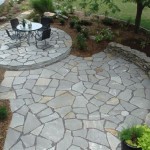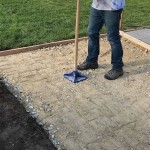How to Effectively Drain Water from a Concrete Patio
Concrete patios are a popular choice for outdoor living spaces due to their durability and weather resistance. However, improper drainage can lead to standing water, which can damage the patio and create a breeding ground for mosquitoes and other pests.
To ensure proper drainage, it's crucial to incorporate several essential aspects into the design and construction of your concrete patio. Here's a comprehensive guide to draining water effectively from a concrete patio:
1. Slope and Grading
The most effective method to drain water from a concrete patio is to build it with a slight slope. This slope should direct water away from the house or any other structures. Ideally, the slope should be graded at a rate of 1/4 inch to 1/2 inch per foot.
2. Drainage Pipes or Downspouts
For patios located near eaves or downspouts, installing drainage pipes or downspout extenders can help divert water away from the patio. These pipes can be connected to the patio's drain system or directed to a nearby drain or storm sewer.
3. French Drains
French drains are underground perforated pipes wrapped in filter fabric that collect and redirect water. They can be installed along the perimeter of the patio or beneath the surface to capture water from the patio and drain it away.
4. Catch Basins and Grates
Catch basins or grates can be installed at strategic locations to collect surface water from the patio. These basins should be connected to a drainage system to ensure proper water disposal.
5. Expansion Joints
Expansion joints are thin gaps or joints between concrete slabs that allow them to expand and contract during temperature changes. These joints also help prevent the buildup of water, as they provide channels for water to drain.
6. Proper Sealant
Sealing the joints between concrete slabs and around drainage systems is crucial to prevent water seepage. Use a high-quality sealant specifically designed for concrete applications to ensure effective water resistance.
7. Hydrostatic Relief
In areas with high groundwater levels, it may be necessary to install a hydrostatic relief system. This system comprises perforated pipes buried beneath the patio that collect and drain excessive groundwater away from the concrete.
8. Regular Cleaning and Maintenance
To maintain effective drainage, it's important to regularly clean the patio, remove debris, and check drainage systems for blockages. Clogged drains or downspouts can hinder proper water flow and lead to standing water issues.
Conclusion
Ensuring proper drainage is essential for the longevity and aesthetics of your concrete patio. By incorporating the aspects discussed above, you can effectively drain water from your patio, prevent damage, and create a comfortable outdoor living space. Remember, regular cleaning and maintenance are crucial to maintaining the effectiveness of your drainage system.

Ponding Water On Concrete Common Causes And How To Fix It

How To Fix Standing Water On Patio The Easy Way Home Logic
Proper Drainage For Backyard And Patio Diy Home Improvement Forum
:strip_icc()/SCM_082_02-cb187f125e1d4e91895de7b809c242f2.jpg?strip=all)
How To Install Drainage Around A Patio Avoid Standing Water

How To Manage Drainage And Runoff With Paver Landscaping

What S Some Ideas To Help Water Drain Away From A Concrete Porch Hometalk

How To Fix Concrete Patio Drainage

The Best Patio Drainage Options Solutions

Putting Drainage In An Existing Patio Home Logic

Patio Drainage System Solutions For Hard Surfaces Expert Advice Buckinghamshire Landscape Gardeners
Related Posts








